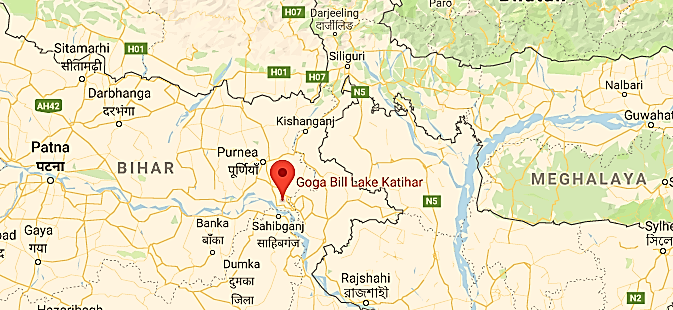Gogabeel: Bihar's First Community Reserve
- 08 Aug 2019
- On 8th August, 2019, Gogabeel in Bihar’s Katihar district which is an ox-bow lake,was announced as the state’s first Community Reserve(CR).
- The water body was notified as a 57 hectare Community Reserve and a 30 hectare Conservation Reserve on August 2, 2019 by Department of Environment, Forest and Climate Change, Bihar.
- It is the 15th Protected Area (PA) in Bihar.
Background:
- Gogabeel was initially notified as a ‘Closed Area’ by the state government in the year 1990 for five years.
- In 2004, Gogabeel, including the neighbouringBagharBeel and BaldiaChaur, were given the status of an Important Bird Area of India (IBA) by the Indian Bird Conservation Network(IBCN).
About Gogabeel Lake:
- Situated in Amdabad block of Katihar district,it stretches to nearly an area of 217.99 acres, of which 143.84 acres is lake possessedby the Government of Bihar.
- It is formed from the flow of the rivers Mahananda and Kankhar in the north and the Ganga in the south and east.
- During monsoons and winter, close to 300 migratory birds come to the lake and its vicinity from the Caspian Sea and Siberian region.
- Among the threatened species, the Lesser Adjutant Stork is listed as ‘Vulnerable’by the IUCN while the Black Necked Stork, White Ibis and White-eyed Pochard are ‘Near Threatened’.
- Other species reported from this site include Black Ibis, Ashy Swallow Shrike, Jungle Babbler, Bank Myna, Red Munia, Northern Lapwing and Spotbill Duck.

What is a Community Reserve(CR)?
Criteria to be declared as CR:
Need for CR:
|
Importance of Protected Areas:
Ecosystems and Species Conservation:
- Theseconserve a variety of species and ecosystems. They have been established in forests, grassland,wetlands, coastal and marine areas, high-altitude pastures or a combination of land types.Their purpose may be to protect a landscape, a patch of forest, ora specific species or its habitat.
- It offer special conservation benefits for species and ecological processes that cannot survive outside these landscapes and support good numbers of rare and threatened species not found elsewhere.
Helps in Minimising Natural Hazards:
- These are crucial in minimising the impacts of a wide range of natural disasters in different habitat types. They absorb excessive rainfall and control stream flows by gradually releasing the water into the soil and the streams and rivers of the watershed.
- They provide space for the escape of floodwaters, weakening their damaging potential. Ecological loss from uncontrolled fires is kept to a minimum in P.As through effective fire-protection measures.
- PAs can reduce or prevent the disastrous effects of hurricanes and storms, for example, the Sunderbans is credited with shielding inland areas from cyclones. Mangroves can reduce the impact of storm waves, and coastal areas with this type of vegetation suffer less than those areas without.
Helps in Maintaining Forest Cover:
- They are a proven instrument to maintain forest cover in large areas and can strengthen the resilience of ecosystems and landscapes to climate change and provide safety through their genetic resources and ecosystem services. For example, while bamboo has disappeared from many areas of central India owing to heavy cattle grazing and frequent fires, the species is supported in several P.As.
Role in Water Conservation:
- These maintain water supplies in a region of fragmented or denuded areas because they can absorb and then gradually release water into the soil, plants and streams. This makes them capable of capturing and storing rainfall during the rainy season and ensuring water availability throughout the year.
- These areas minimise their net water flow, resulting in low run-off. They are sources of many important rivers and streams.
Reducing Water Contamination:
- Natural wetlands and grasslands play an important role in reducing contamination levels in water. The quality of such water is generally better than that obtained from ordinary catchment areas. In addition, effectively managed P.As may also help control the emergence and rapid spread of a wide range of diseases, including malaria, trypanosomiasis and filariasis, which are reported to be caused by massive ecological disturbances.
Source of Livelihood:
- PAs play a vital role in the rural economy. In many areas, forests and trees are among the few resources that are available to rural dwellers. They provide different kinds of benefits: jobs and incomes often needed to supplement inadequate returns from agriculture; produce such as fuel wood, food, fodder and building poles for the home; and a range of environmental benefits, without which other activity, such as agriculture might be impossible.
Conservation of Wild Relatives of Crops:
- The wild relatives of crops are conserved by P.As. These plant species are the main source of much of the genetic material used for crop breeding. Also, these are vital sources of important traditional medicines and support a wide range of natural genetic resources, providing material for commercial medications.
Way Forward:
- Protected areas are important tools for the conservation of biological diversity and are cornerstones of sustainable development strategies. They are tried and tested approach that have been put in application for centuries to conserve nature and related cultural resources by local communities, indigenous peoples, governments and other organisations.
- As the world is keeping up with constant developmenttaking place rapidly, constraints on ecosystems and natural resources are escalating. Protected areas, when administeredrightly and embedded in development strategies, can offer nature-based solutions to this problem, and take their place as an integral component of sustainable development.




